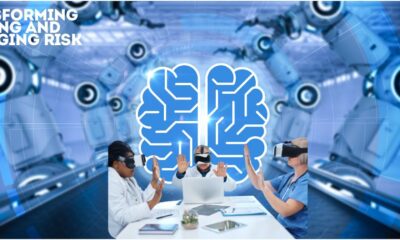Education
AI in Education: Enhancing Learning with Tech

Artificial Intelligence (AI) is changing the way we learn and teach. In education, AI can help tailor lessons to fit individual needs, making learning more effective and engaging. This article explores how AI is enhancing education by personalising learning, improving assessments, and preparing students for a tech-driven future.
Key Takeaways
- AI personalises learning experiences by adapting to each student’s needs.
- Automated assessments provide quick feedback, helping teachers track student progress.
- AI tools can support teachers by reducing their administrative workload.
- Educational games powered by AI make learning fun and interactive.
- Teaching students about AI is essential for preparing them for future careers.
The Role of AI in Personalising Education
Tailoring Learning Experiences
AI technology is transforming how education is delivered by customising learning experiences for each student. This means that lessons can be adjusted based on individual progress and preferences. For instance, AI can analyse a student’s performance and suggest resources that match their learning style, making education more effective.
Addressing Diverse Learning Needs
Every student learns differently, and AI helps in addressing these diverse needs. By using AI tools, educators can:
- Identify students who may need extra help.
- Provide resources tailored to different learning abilities.
- Create inclusive environments for neurodiverse students.
Enhancing Student Engagement
AI can also boost student engagement by making learning more interactive and enjoyable. For example, gamified learning experiences powered by AI can motivate students to participate actively in their education. This approach not only makes learning fun but also helps in retaining information better.
AI in education is not just about technology; it’s about creating a more inclusive and effective learning environment for all students.
In summary, the role of AI in personalising education is significant. It tailors learning experiences, addresses diverse needs, and enhances engagement, paving the way for a more effective educational landscape.
AI-Driven Assessment and Analytics
Real-Time Performance Tracking
AI is changing how we track student performance. With real-time analytics, teachers can see how students are doing at any moment. This helps them understand which areas need more focus. For example, a teacher can quickly identify if a student struggles with a specific topic and provide extra help right away.
Automated Grading Systems
Grading can take a lot of time, but AI can help. Automated grading systems can mark tests and assignments quickly. This means teachers can spend less time on paperwork and more time with students. Here’s a quick look at how AI grading works:
| Task | Traditional Method | AI Method |
|---|---|---|
| Grading Essays | Manual | Automated |
| Feedback Time | Days | Minutes |
| Teacher’s Focus | Paperwork | Student Interaction |
Data-Driven Insights for Educators
AI doesn’t just help with grading; it also provides valuable insights. By analysing data, AI can show trends in student learning. This means teachers can adjust their lessons based on what works best. Here are some benefits of using AI for insights:
- Identifies common areas where students struggle.
- Helps in creating tailored lesson plans.
- Provides feedback on teaching methods.
AI in education is not just about technology; it’s about making learning better for everyone. By using AI, we can ensure that every student gets the support they need to succeed.
In summary, AI-driven assessment and analytics are transforming education. With tools that track performance, automate grading, and provide insights, teachers can focus more on teaching and less on administrative tasks. This leads to a more engaging and effective learning environment for students.
Adaptive Learning Platforms: Customising Education in Real-Time
Adaptive learning platforms are changing how students learn by providing personalised experiences tailored to each individual’s needs. These systems adjust the content and pace of learning based on real-time assessments, ensuring that every student can progress at their own speed.
How Adaptive Learning Works
- Continuous Assessment: These platforms use ongoing evaluations to understand a student’s strengths and weaknesses.
- Real-Time Adjustments: As students interact with the material, the system modifies the learning path to suit their needs.
- Feedback Mechanisms: Immediate feedback helps students understand their mistakes and learn from them quickly.
Benefits of Adaptive Learning
- Personalised Learning: Each student receives a unique learning experience that caters to their specific needs.
- Increased Engagement: By providing relevant content, students are more likely to stay interested and motivated.
- Improved Outcomes: Studies show that adaptive learning can lead to better academic performance compared to traditional methods.
Challenges and Considerations
- Implementation Costs: Setting up adaptive learning systems can be expensive for schools.
- Training for Educators: Teachers need proper training to effectively use these platforms.
- Data Privacy: Protecting student data is crucial as these systems collect personal information.
Adaptive learning platforms represent a significant step towards making education more inclusive and effective for all students. By focusing on individual needs, they help bridge the gap between different learning abilities.
| Feature | Description |
|---|---|
| Personalisation | Tailors content to individual learning styles |
| Engagement | Keeps students motivated with relevant material |
| Feedback | Provides immediate responses to student actions |
Intelligent Tutoring Systems: The Future of One-on-One Learning
Simulating Human Tutoring
Intelligent tutoring systems (ITS) are designed to mimic the experience of having a personal tutor. These systems can provide tailored support in subjects like math and languages. They adapt to each student’s learning pace, ensuring that no one is left behind.
Examples of Intelligent Tutoring Systems
Some popular examples of ITS include:
- Duolingo: A language learning app that adjusts its lessons based on user performance.
- Khan Academy’s Khanmigo: Offers personalised learning paths in various subjects.
- Mathway: Provides step-by-step solutions to math problems, helping students understand concepts better.
Impact on Student Outcomes
Research shows that students using intelligent tutoring systems often achieve better results compared to those in traditional classrooms. This is because these systems:
- Offer immediate feedback, helping students correct mistakes on the spot.
- Personalise learning experiences, catering to individual strengths and weaknesses.
- Encourage self-paced learning, allowing students to progress when they are ready.
Intelligent tutoring systems represent a significant leap in educational technology, making learning more accessible and effective for everyone.
In conclusion, as AI innovations continue to evolve, intelligent tutoring systems are set to play a crucial role in shaping the future of education, providing students with the support they need to succeed.
AI in Supporting Digital and AI Literacy
Bridging the Digital Skills Gap
In today’s world, digital skills are essential for success. Many students lack the necessary skills to thrive in a tech-driven environment. To bridge this gap, schools can:
- Integrate technology into everyday lessons.
- Provide training for both students and teachers.
- Encourage collaboration on tech projects.
Preparing Students for AI-Driven Jobs
As AI becomes more prevalent, preparing students for future careers is crucial. Schools should focus on:
- Teaching coding and programming basics.
- Encouraging critical thinking and problem-solving.
- Offering internships or projects related to AI.
Ethical Considerations in AI Education
With the rise of AI, it’s important to address ethical issues. Educators must:
- Discuss the implications of AI in society.
- Teach students about data privacy and security.
- Ensure that AI tools used in classrooms are unbiased and fair.
AI can enhance learning, but it must be implemented thoughtfully to avoid widening the digital divide. Schools need to ensure that all students have equal access to technology and resources.
AI-Powered Educational Games: Learning Through Play
The Evolution of Educational Games
Educational games have come a long way since the days of simple computer programmes. Today, AI-powered games adapt to each player’s learning style, making education more engaging and effective. These games not only entertain but also teach important skills.
Benefits of AI in Educational Games
- Personalised Learning: AI can adjust the difficulty level based on the player’s performance, ensuring that each student is challenged appropriately.
- Immediate Feedback: Players receive instant feedback, helping them understand their mistakes and learn from them right away.
- Engagement: The interactive nature of these games keeps students interested and motivated to learn.
Popular AI-Powered Educational Games
| Game Title | Subject Area | Age Group |
|---|---|---|
| Prodigy Math | Mathematics | 6-14 years |
| Kahoot! | General Knowledge | All ages |
| Duolingo | Language Learning | 8+ years |
AI-powered educational games are not just about fun; they are a powerful tool for enhancing learning experiences. By integrating play into education, we can foster a love for learning that lasts a lifetime.
In conclusion, as we embrace AI in education, we must remember that play is essential for learning. By leveraging technology, we can create a more inclusive and effective educational environment for all students.
The Impact of AI on Teacher Workloads
Automating Administrative Tasks
AI can significantly reduce the time teachers spend on administrative duties. By automating tasks such as grading and attendance tracking, educators can focus more on teaching. This shift allows for more meaningful interactions with students. Here are some common tasks that AI can automate:
- Grading assignments and tests
- Managing student records
- Scheduling meetings and reminders
Enhancing Teacher-Student Interactions
With AI handling routine tasks, teachers can dedicate more time to engaging with their students. This can lead to:
- Improved student understanding through personalised feedback.
- Increased opportunities for one-on-one support.
- Enhanced classroom discussions and collaboration.
Challenges in Implementation
Despite the benefits, integrating AI into education comes with challenges. Some of these include:
- Resistance to change from educators who are accustomed to traditional methods.
- Concerns about data privacy and security.
- The need for training to effectively use AI tools.
As AI continues to evolve, it is crucial for educators to adapt and embrace these technologies to enhance their teaching practises. The future of education relies on a balanced approach that combines technology with human interaction.
Equity and Accessibility in AI-Enhanced Education
Addressing the Digital Divide
AI technology tools hold remarkable promise for providing more accessible learning experiences for students with disabilities. However, there is a risk that these tools could widen the gap between students with different backgrounds. To tackle this issue, it is essential to:
- Ensure all students have access to the necessary technology.
- Provide training for teachers on how to use AI tools effectively.
- Involve community stakeholders in the decision-making process.
Ensuring Inclusive Learning
Creating an inclusive learning environment is vital. This can be achieved by:
- Designing AI tools that cater to diverse learning needs.
- Regularly assessing the effectiveness of these tools in real classroom settings.
- Encouraging feedback from students and educators to improve AI applications.
Policy Recommendations for Equity
To promote equity in AI-enhanced education, policymakers should consider the following recommendations:
- Invest in infrastructure to support low-income schools.
- Develop guidelines to ensure AI tools are free from bias.
- Foster partnerships with organisations that focus on digital literacy for underrepresented groups.
By prioritising equity in AI education, we can create a more inclusive environment that benefits all learners, regardless of their background.
Future Trends in AI and Education

As we look ahead, the integration of artificial intelligence in education is set to transform learning experiences significantly. Here are some key trends to watch:
Emerging AI Technologies in Education
- Personalised Learning: AI will enable tailored educational experiences, adapting to each student’s unique needs.
- Enhanced Assessment Tools: New AI-driven tools will provide real-time feedback, helping educators track student progress more effectively.
- Virtual Reality (VR) and Augmented Reality (AR): These technologies will create immersive learning environments, making complex subjects more engaging.
Predictions for the Next Decade
- Increased Automation: Routine tasks will be automated, allowing teachers to focus on more meaningful interactions with students.
- Greater Accessibility: AI will help bridge the digital divide, ensuring all students have access to quality education.
- Collaborative Learning: AI will facilitate group learning experiences, promoting teamwork and communication skills among students.
Preparing for Future Challenges
- Ethical Considerations: As AI becomes more prevalent, it’s crucial to address ethical concerns, ensuring fair use and data privacy.
- Teacher Training: Educators will need ongoing training to effectively integrate AI tools into their teaching practises.
- Policy Development: Governments and institutions must create policies that support the responsible use of AI in education.
The future of education lies in the collaboration between technology and teaching, ensuring that AI enhances rather than replaces the human element in learning.
| Trend | Description |
|---|---|
| Personalised Learning | Tailored experiences for each student |
| Enhanced Assessment Tools | Real-time feedback for better tracking |
| VR and AR Learning | Immersive environments for complex subjects |
Collaborative Approaches to AI Integration in Education
Incorporating AI into education requires teamwork among various groups. Collaboration is key to ensure that AI tools meet the needs of students and teachers alike.
Involving Stakeholders in AI Adoption
- Teachers: They provide insights on classroom needs and how AI can assist in teaching.
- Parents: Their feedback helps understand the home environment and student needs.
- Students: Their experiences and preferences are crucial for designing effective AI tools.
Co-Designing AI Solutions with Educators
- Workshops: Regular sessions where educators can share their ideas and concerns about AI tools.
- Pilot Programmes: Testing AI tools in real classrooms to gather feedback and make improvements.
- Continuous Training: Offering professional development for teachers to understand and use AI effectively.
Best Practises for Implementation
- Start Small: Begin with a few AI tools and gradually expand based on feedback.
- Gather Data: Use analytics to understand how AI is impacting learning outcomes.
- Ensure Equity: Make sure all students have access to AI tools, regardless of their background.
Collaboration among all parties involved in education is essential for the successful integration of AI. This ensures that the technology is used effectively and benefits everyone.
By working together, we can create a more inclusive and effective educational environment that leverages the power of AI to enhance learning experiences.
Highlight
The transformative impact of artificial intelligence across various industries, including education, is significant. Understanding this can help us better integrate AI into our learning systems.
Teaching About AI: Building AI Literacy in Students
Importance of AI Literacy
Teaching students about AI literacy is essential in today’s tech-driven world. Understanding AI helps students navigate the digital landscape and prepares them for future careers. Here are some key reasons why AI literacy is important:
- Empowerment: Students learn to use AI tools effectively.
- Critical Thinking: They develop skills to assess AI’s impact on society.
- Career Readiness: Knowledge of AI opens doors to various job opportunities.
Curriculum Development for AI Education
Creating a curriculum that includes AI education involves several steps:
- Identify Learning Objectives: Define what students should know about AI.
- Integrate AI Concepts: Include AI topics in existing subjects like maths and science.
- Hands-On Activities: Use projects and experiments to make learning engaging.
Resources for Teaching AI
To effectively teach AI, educators can use various resources:
- Online Courses: Platforms like Coursera and edX offer AI courses for students.
- Interactive Tools: Use AI-based applications to demonstrate concepts.
- Community Programmes: Collaborate with local organisations to provide workshops.
Teaching about AI is not just about technology; it’s about preparing students for a future where they can thrive in an AI-driven world.
In conclusion, building AI literacy in students is crucial for their personal and professional growth. By integrating AI education into the curriculum, we can ensure that all students are equipped with the skills they need to succeed in a rapidly changing environment.
Conclusion
In summary, the role of AI in education is becoming increasingly important. It offers exciting possibilities for personalising learning and improving how we assess students. By using AI tools, teachers can save time on administrative tasks and focus more on helping their students. However, it is crucial to ensure that these technologies are used fairly and effectively, so all students benefit. As we move forward, we must embrace AI thoughtfully, ensuring it enhances the learning experience while also preparing students for a future where technology plays a big role.
Frequently Asked Questions
How does AI help in personalising education?
AI can tailor learning experiences to fit each student’s needs, making lessons more effective. It can adapt to different learning styles and paces.
What are intelligent tutoring systems?
These are computer programmes that provide one-on-one help to students, similar to a human tutor. They can focus on specific subjects like maths or languages.
How does AI improve assessment in schools?
AI can quickly track student performance and provide feedback, helping teachers understand where students need more help.
What are adaptive learning platforms?
These are educational tools that change the content and activities in real-time based on how well a student is doing.
How can AI support teachers?
AI can automate administrative tasks, giving teachers more time to interact with students and focus on teaching.
What role does AI play in developing digital skills?
AI helps students learn essential digital skills, preparing them for jobs that require technology knowledge.
Are there any challenges with using AI in education?
Yes, there are concerns about equity, data privacy, and ensuring that AI tools are used effectively without replacing human teachers.
How are AI-powered educational games beneficial?
These games make learning fun and interactive, helping students grasp concepts while playing.
-

 Home and Garden5 days ago
Home and Garden5 days agoTransform Your Space: A Guide to Minimalist House Interior Design in 2025
-

 Home & Family5 days ago
Home & Family5 days ago10 Essential Cleaning Hacks for Bathroom Surfaces You Need to Try
-

 Health & Fitness5 days ago
Health & Fitness5 days agoDiscovering the Best Multivitamin for Women Over 40: Essential Nutrients for Optimal Health
-

 Crime5 days ago
Crime5 days agoExploring the Most Anticipated New True Crime Documentaries of 2025
-

 Health & Fitness5 days ago
Health & Fitness5 days agoDiscover the Best Multivitamin for Women Over 40: A Comprehensive Guide to Optimal Health
-

 Automotive4 days ago
Automotive4 days agoUnlocking Performance: Why the HP Spectre x360 is the Ultimate 2-in-1 Laptop for 2025
-

 Business5 days ago
Business5 days agoMaximize Your Earnings with American Express High Yield Savings Accounts in 2025
-

 Artificial Intelligence5 days ago
Artificial Intelligence5 days agoBreaking Generative AI News: Innovations Shaping the Future of Technology






































